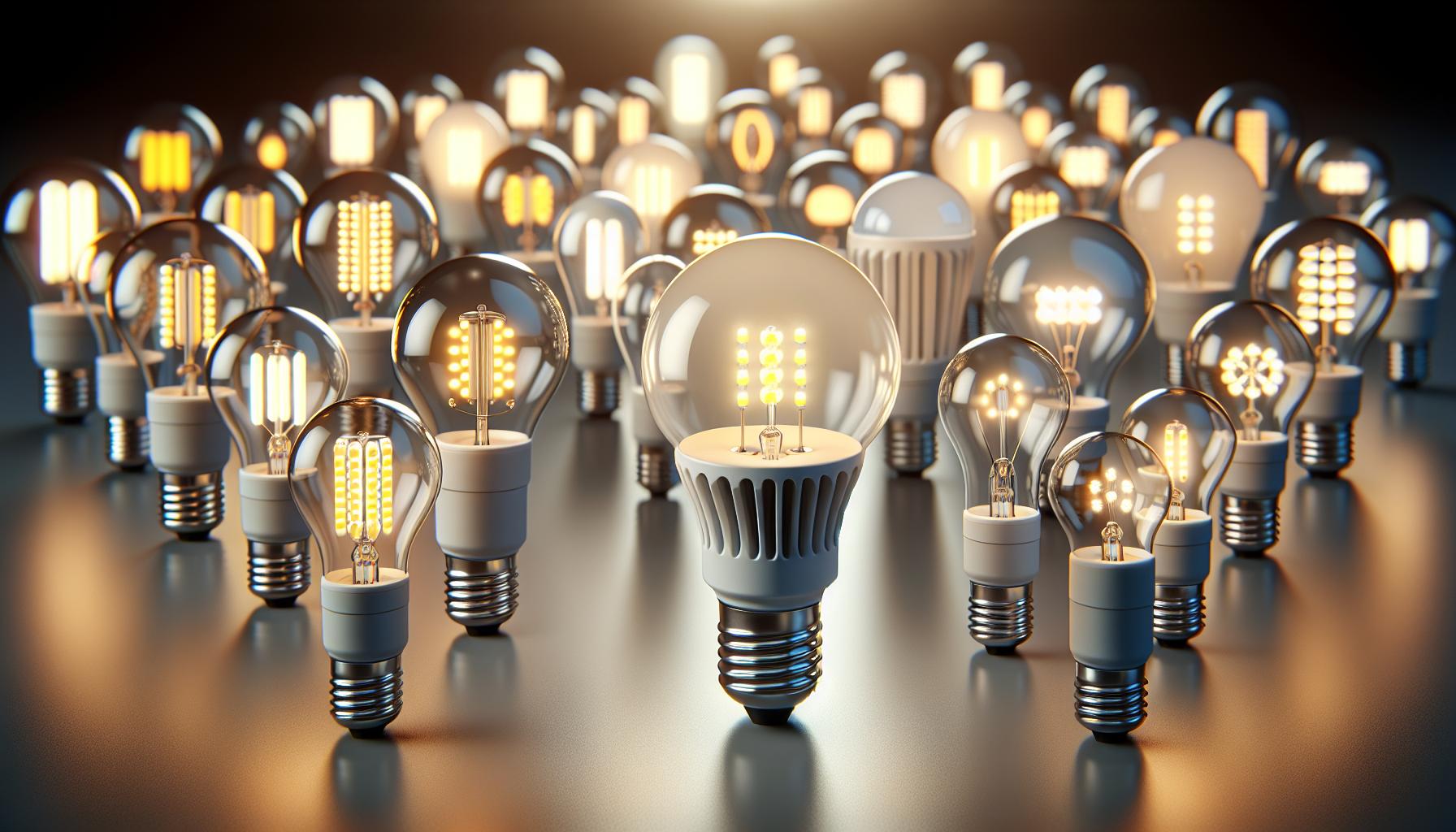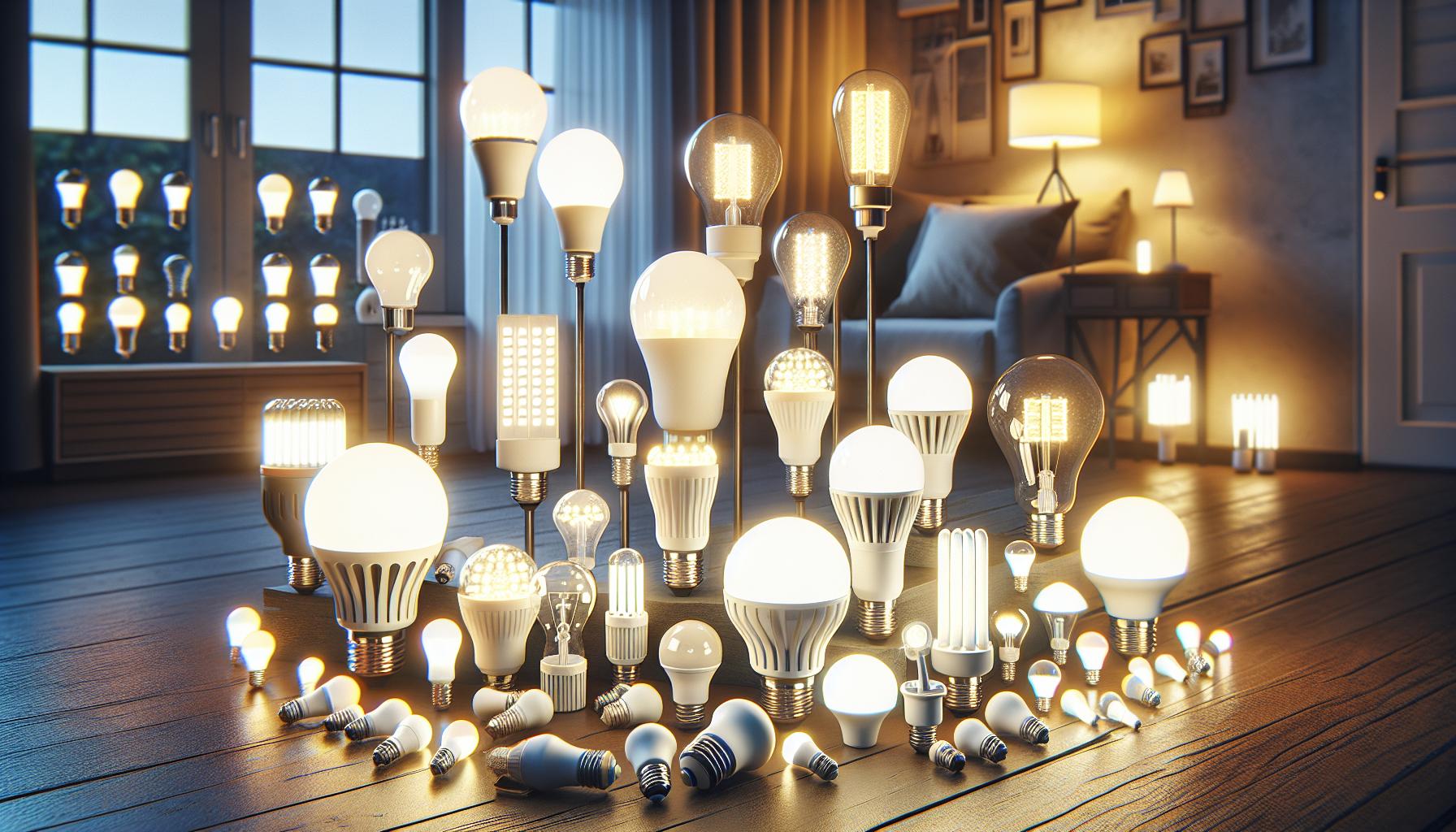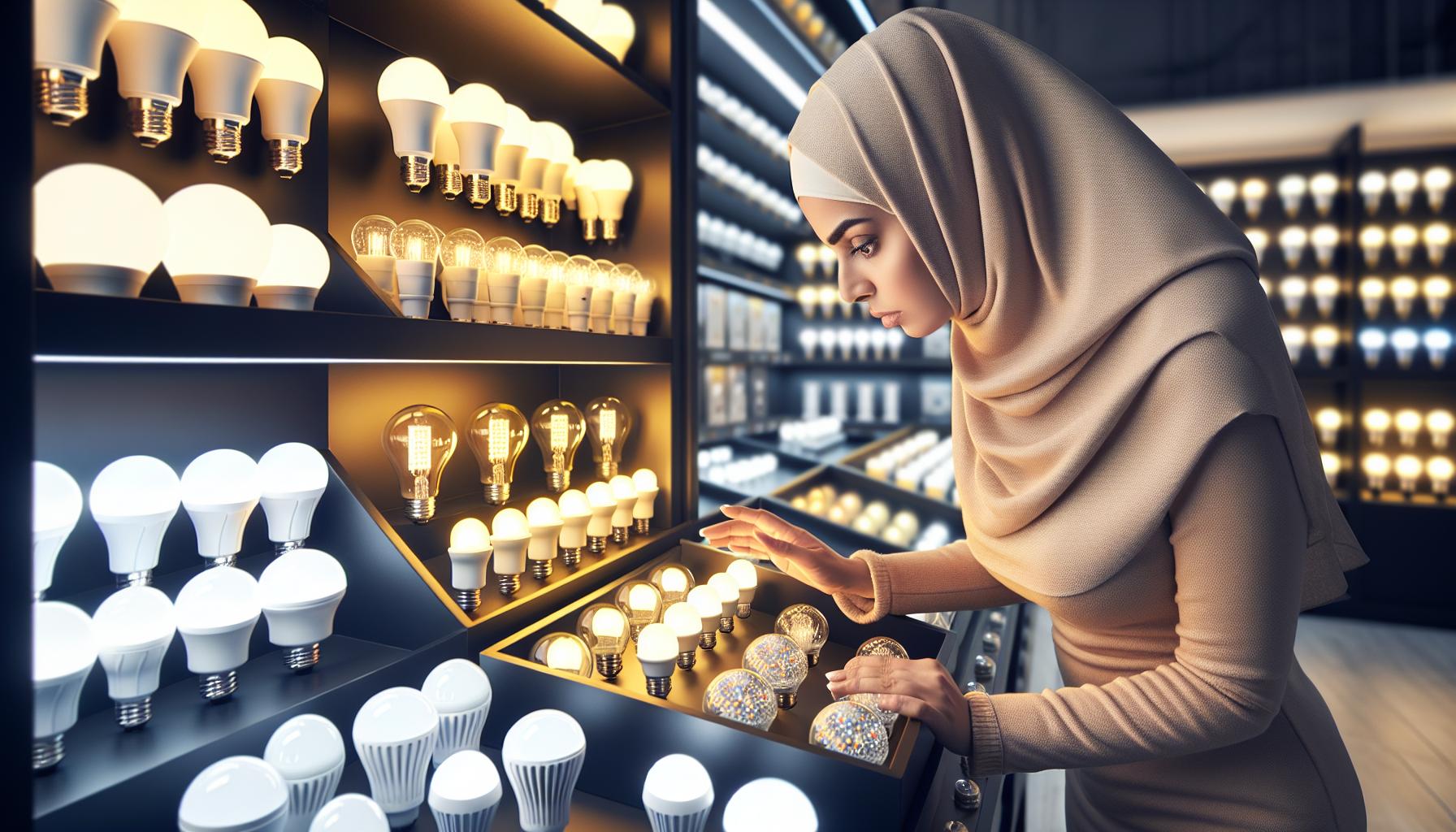Ever wondered why LED light bulbs are all the rage these days? You’re not alone. With energy bills on the rise, it’s no surprise you’re looking for ways to cut costs and save energy. LED bulbs might just be the bright solution you’re searching for.
When you switch on a light, you might not think about the type of bulb you’re using. But the truth is, the kind of bulb you choose can make a significant difference in your electricity usage. And LEDs? They’re in a league of their own when it comes to efficiency.
So, let’s shed some light on the subject. Are LED light bulbs really the superheroes of savings? Stick around, and you’ll find out just how these nifty little bulbs can make a big impact on your energy consumption.
How do LED light bulbs work?
When you flip on a switch, you might not think about the incredible process happening inside that LED bulb to illuminate your space. But as a lighting enthusiast with a penchant for DIY, you’ll find the inner workings of these bulbs both fascinating and ingenious.
LED stands for Light Emitting Diode, and these diodes are the secret to the efficiency of LED bulbs. Unlike incandescent bulbs that use filaments or CFLs with their gas-filled tubes, LEDs emit light when electrons pass through a semiconductor material. This electrical current causes the diodes to light up, and because the process doesn’t generate much heat, it’s extremely efficient.
What’s mesmerizing about LED technology is its capability to convert a high percentage of electricity directly into light. You’re looking at an energy conversion rate that knocks traditional lighting out of the park. The efficiency of an LED bulb is the result of its:
- Small size
- Durability
- Longevity
LEDs are small enough to fit into intricate, compact designs, which your creative DIY projects might demand. This is a game-changer for crafting custom lighting solutions around your home. And if you’re someone who dislikes replacing bulbs frequently, you’ll appreciate that LEDs last substantially longer than their counterparts.
Let’s dive into a little comparison:
| Bulb Type | Average Lifespan | Wattage per 800 Lumens |
|---|---|---|
| LED | 25,000 hours | 8-10 Watts |
| Incandescent | 1,000 hours | 60 Watts |
| CFL | 8,000 hours | 13-15 Watts |
The table above gives a snapshot of just how significant the differences are. When you’re working on your next home project, remember that opting for LED lighting not only reflects your savvy DIY skills but also your commitment to energy efficiency. With a solution that’s both cost-effective and long-lasting, LEDs truly represent the smart choice in lighting.
The advantages of LED light bulbs
When you’re deep into your weekend DIY projects, don’t overlook the importance of lighting. Switching to LED bulbs is not just a bright idea—it’s revolutionary. You’ll not only illuminate your space effectively but also reap a myriad of benefits that surpass the capabilities of traditional bulbs.
Energy Savings at a Glance
LED light bulbs shine when it comes to energy efficiency. They require significantly less power to produce the same amount of light. An LED typically uses about 80% less energy compared to incandescent bulbs. This stark difference culminates in lower electricity bills and a reduced carbon footprint. You get the satisfaction of a well-lit home and the pride in promoting sustainability.
| Type of Bulb | Average Wattage Used |
|---|---|
| Incandescent | 60W |
| CFL | 14W |
| LED | 10W |
The table above clearly shows why LEDs are the frontrunners in energy conservation.
« Why is Light Bulb Important? Discover Its Role in Safety and Productivity
Why Did My Light Bulb Explode When Switched On? Uncover Shocking Reasons Now »
Durability and Longevity
Your projects deserve a reliable source of light. LEDs boast an impressive life span that can reach up to 50,000 hours—that’s years of consistent, quality light. Unlike their incandescent counterparts that fade quickly, LEDs maintain their brilliance, providing a constant level of illumination throughout their lifespan. Plus, they’re made from sturdy materials, mitigating the risk of breakage from the occasional knock or drop.
Instant Full Brightness
Ever flick on an old-school fluorescent bulb and wait for it to stop flickering? With a quick flip of the switch, LEDs burst into full luminosity instantly. You’ll never have to waste a moment waiting for your bulbs to ‘warm up,’ which is especially crucial when you’re measuring, cutting, or installing in your projects.
LEDs not only embody efficiency but also enhance your home through their sheer performance. Their minimal energy consumption paired with longevity and immediate brightness make them the ultimate choice for the discerning homeowner and avid DIYer. They reflect your commitment to quality, convenience, and energy consciousness in every flicker-free shine.
Do LED light bulbs use less electricity?
Absolutely, LED light bulbs consume significantly less electricity than their incandescent and halogen counterparts. As you dive into your next DIY project, imagine your home aglow with energy-efficient lighting. LED bulbs are the champions of lower energy consumption, requiring up to 75% to 80% less power than incandescent bulbs. In your quest for a greener home, consider this; swapping out traditional bulbs for LEDs can make a noticeable difference in your energy bill. Let’s break down the numbers.
| Bulb Type | Watts Used | Life Expectancy (hours) |
|---|---|---|
| Incandescent | 60 | 1,000 |
| LED | 10 | 50,000 |
In terms of actual cost savings, here’s what you might expect:
- Energy bill reduction: Given that residential electricity prices average about 13 cents per kilowatt-hour, switching to LEDs could save over $100 annually for every 10 bulbs replaced.
- Fewer bulb replacements: Since LEDs last so much longer, you’ll also save money and time by not needing to purchase and replace bulbs as frequently.
Instant full brightness is another perk of LEDs that’s too good not to mention. There’s no lag time—they’re at maximum brightness the moment you flip the switch. This is particularly handy during those DIY sessions when you need clarity and precision in your workspace.
Think about the variety of LED options available too. You’ve got dimmable LEDs for setting the mood, smart bulbs that pair with your home automation, and an array of colors to fit any decorating scheme. Plus, LEDs are robust, standing up well to on-off cycling—so if you’re the type to forget the lights on, your LED can handle it.
Remember, when you’re perusing the lighting aisle for your next home improvement project, LED bulbs aren’t just about energy savings. They’re about adopting an innovative solution that brightens your space while acknowledging the responsibility we all share to conserve energy.
Comparing LED light bulbs to other types of bulbs
As you consider different lighting options for your DIY projects, it’s essential to understand how LED light bulbs stack up against traditional bulbs like incandescents and CFLs (compact fluorescent lamps).
LEDs, or light-emitting diodes, are the latest innovation in lighting technology. They use a semiconductor to convert electricity into light. Unlike incandescents that produce light by heating a wire filament or CFLs which use a tube containing argon and a small amount of mercury vapor, LEDs generate light through electroluminescence. This fundamental difference in technology is what makes LEDs superior in terms of energy efficiency.
Here’s a simple breakdown to give you a clearer picture:
- Incandescent Bulbs: They have been illuminating homes for more than a century but are highly inefficient, with about 90% of their energy given off as heat rather than light.
- Compact Fluorescent Lamps (CFLs): These bulbs are more energy-efficient than incandescent bulbs, but they still can’t hold a candle to LEDs. They take a bit to warm up to full brightness, and their life expectancy is shorter compared to LEDs.
If you’re into numbers, check out this comparison table:
| Bulb Type | Average Lifespan (Hours) | Watts Used (Standard 60W Equivalent) |
|---|---|---|
| Incandescent | 1,000 | 60 |
| CFL | 8,000 | 13-15 |
| LED | 25,000 | 8-10 |
It’s clear that LEDs not only last longer but also consume significantly less power for the same light output. This is why they’re a favorite for sustainable home lighting solutions. Additionally, because they don’t contain mercury, LEDs are safer for your home environment.
For you, the avid DIYer, versatility is key. LEDs offer an unmatched variety of color temperatures and styles, perfect for any project. Whether you’re looking for a warm glow for a cozy bedroom or bright, task lighting for a kitchen workspace, there’s an LED option out there. Not to forget, smart LED bulbs integrate seamlessly with home automation systems, adding both convenience and sophistication to your lighting setup.
Tips for choosing and using LED light bulbs
When you’re ready to make the switch to LEDs, knowing how to pick the right ones can feel a bit like navigating a maze with all the options out there. Brightness, color temperature, and energy usage are key factors, but there’s more to it than just numbers on a package.
Start with brightness. You’re used to measuring light in watts, but LED efficiency means you need to think in lumens. More lumens equal brighter light; less means dimmer light. If you want to replace a 60-watt incandescent bulb, look for an LED that offers about 800 lumens.
Next, consider the mood you want to set. Color temperature is measured in Kelvin (K) and ranges from warm to cool. A bulb with a lower Kelvin number will give off a warmer, yellower glow, perfect for cozy living spaces. Higher Kelvin numbers mean a cooler, bluer light, like morning sunlight. Aim for 2,700K to 3,000K for warm lighting and 5,000K to 6,500K for cool lighting.
Dimmability is a feature many love but check if your LEDs are compatible with your dimmer switches. Not all LED bulbs dim the same way, so to avoid a flickering or a non-functional dimmer, opt for LEDs labeled as dimmable and ensure your dimmer switch is LED-compatible.
For those tech-savvy folks, smart LED bulbs are an exciting option. They offer features like remote control via smartphone apps, the ability to change colors, and even sync with your home assistant devices. Imagine adjusting your lights for a movie night or setting timers for them to turn on before you get home—all from your phone.
Remember to always check the Energy Star rating for quality assurance. These bulbs have been tested for color quality, light output, and efficiency. By choosing a bulb with a good Energy Star rating, you’re ensuring the best performance and the highest savings on your energy bill.
Conclusion
So you’ve seen just how much you stand to gain by switching to LED light bulbs. They’re not just a bright idea for your home; they’re a smart choice for your wallet and the environment too. With the longer lifespan, lower energy consumption, and the variety of options available, it’s clear that LEDs are the way to go. Remember to keep an eye out for that Energy Star rating to ensure you’re getting the best quality. Happy lighting!
Frequently Asked Questions
What are the main advantages of LED light bulbs?
LED light bulbs are energy-efficient, consuming less electricity than incandescent and halogen bulbs. They offer cost savings on energy bills and have a longer lifespan. Additionally, they provide instant full brightness and come in dimmable and smart bulb options.
How do LED bulbs compare to incandescent bulbs in terms of energy usage?
LED bulbs consume significantly less energy than incandescent bulbs. They use fewer watts for the same level of brightness, which can result in substantial energy savings over time.
What should I consider when choosing an LED light bulb?
When selecting an LED bulb, consider brightness, color temperature, and whether you need features like dimmability or smart connectivity. Also, check for the Energy Star rating to ensure quality and efficiency.
Are LED bulbs more cost-effective than CFL bulbs?
Yes, LED bulbs are generally more cost-effective than CFL bulbs. They use less energy and last longer, which means less frequent replacements and lower energy costs in the long run.
Can LED bulbs reach full brightness instantly?
Unlike some energy-saving bulbs, LED bulbs reach full brightness immediately when switched on, with no warm-up time needed.
What are smart LED bulbs and why might I need them?
Smart LED bulbs can connect to your home Wi-Fi or smart home system, allowing you to control lighting remotely, set schedules, and sometimes even adjust color temperature or color. They’re useful for convenience, energy savings, and home automation.
Why is it important to look for the Energy Star rating on LED bulbs?
Looking for the Energy Star rating is important as it indicates the bulb has been tested for energy efficiency and performance. Energy Star-rated bulbs meet strict efficiency, brightness, and lifespan criteria.





